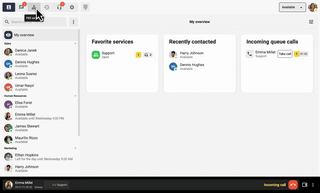IP telephony follows the same principle as regular telephony. The only difference is that you make calls online – which means lower costs. So no matter where you are, you can call the same number as long as you have an internet connection. Here we help you find the right plan for you and your business!
Business IP telephony is convenient because you most likely already have an internet connection. Why wouldn’t you take advantage of it and start making calls online too? However, the needs of different companies are also different when it comes to IP telephony. There are huge companies with straightforward needs and start-ups that need advanced solutions. Some companies that need fixed numbers want to combine fixed telephony with IP telephony – others want to get rid of their phone jacks as quickly as possible.
Whether you already have a subscription or are thinking of investing in one, you will be faced with a jungle of providers offering different licenses and subscriptions for IP telephony. To make sure it’s the right one for you, here are some tips to keep in mind.
5 things to look for in an IP telephony subscription
1. notice period
Many providers use a notice period – but since 2014 it can be a maximum of one month. It is therefore important that you review your contract to make sure you know what applies. On the other hand, there are also a number of providers that don’t use any notice period at all. Many just let the subscription run until the next month before terminating it.
2. commitment period
Long lock-in periods used to be the norm, but more and more providers are doing away with them altogether. You can, of course, cancel a subscription before the binding period has expired, but it will still not be terminated until after the period of time you initially committed to. So don’t forget that you will be liable to pay for the entire period.
To avoid getting a notice period after your commitment period has expired – cancel your contract at least one month before!
3. Current contract and monthly fee
If you are paying a lot for variable costs with a relatively high per-minute fee, but have a low monthly fee, it might be worth trying to switch to a different subscription. If you find another solution with no monthly fee and lower variable costs, it may actually be more economical to start a new subscription – even if you have a fixed term left on your old one.
4. Set requirements for suppliers
An effective way to get a better deal on IP telephony is to send your latest bill to another provider to see if they can match – or beat – it. You’ll need to look at the countries you mainly call, the volume of calls you make and the additional services you currently pay for, such as IVR.
5. additional features and services
Features that may cost extra include linking voicemail to email addresses, using queuing systems and fax mailboxes, as well as routing calls to multiple answering points, queuing systems, etc. These types of additional services can be expensive, so review which features and services are included in your current contract and which you are paying extra for, and compare it to other subscriptions.
Is there a one-size-fits-all IP telephony subscription?
In fact, there may be subscriptions that would suit all businesses. Basically, the main issue is that many people try to chase a golden solution where everything is included. So think about what features you really need. Then try to find a plan that is cost-effective, but is easy to use in the first place.
A solution that is easy to handle for everyone in the company regardless of IT experience benefits everyone! Think about it instead of falling for an advanced solution where cool features are put before ease of use.

